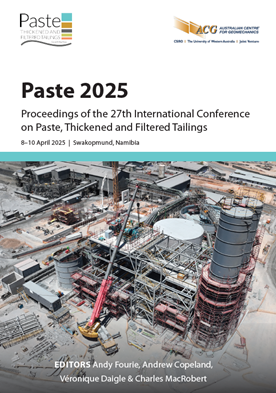The RhoVie™ Slack Screen Densifier: a novel primary dewatering process for fine, high-clay-containing tailings

|
Authors: Vietti, AJ |
DOI https://doi.org/10.36487/ACG_repo/2555_38
Cite As:
Vietti, AJ 2025, 'The RhoVie™ Slack Screen Densifier: a novel primary dewatering process for fine, high-clay-containing tailings', in AB Fourie, A Copeland, V Daigle & C MacRobert (eds), Paste 2025: Proceedings of the 27th International Conference on Paste, Thickened and Filtered Tailings, Australian Centre for Geomechanics, Perth, pp. 541-548, https://doi.org/10.36487/ACG_repo/2555_38
Abstract:
The drive towards so-called dry stacked tailings necessitates that the mine tailings undergo two dewatering steps, i.e. primary dewatering, which typically utilises gravity sedimentation technologies such as thickeners, followed by secondary dewatering, in which a variety of dewatering technologies such as vacuum or pressure filters, centrifuges and presses can be utilised. Incorporating various concepts from inline flocculation to static and dynamic screening, the RhoVie™ Slack Screen Densifier was developed to provide an alternative primary dewatering process for fine highclaycontaining tailings. The technology has several significant advantages such as low complexity, low power requirement and a low footprint, which allows for mobility depending on mining process or tailings deposition site locality. The development of this technology potentially provides an opportunity for an alternative dry stacking flow sheet for high-clay-containing tailings streams to be utilised.
Keywords: clays, dewatering, dry stacking, filtration, flocculation, thickening
References:
Amoah, N 2024, ‘The place for filtered tailings and stacking in the search for safe and sustainable tailings management’, in AB Fourie & D Reid (eds), Paste 2024: Proceedings of the 26th International Conference on Paste, Thickened and Filtered Tailings, Australian Centre for Geomechanics, Perth, pp. 3–24,
Cacciuttulo, C & Atencio, E 2023, ‘Dry stacking of filtered tailings for large-scale production rates over 100,000 metric tons per day: Envisioning the sustainable future of mine tailings storage facilities’, Minerals, vol. 13, pp. 1–30.
Copeland, AM, Lyell, KA & van Greunen, P 2006, ‘Disposal of belt filtered tailings – Skorpion Zinc case study: Feasibility, design and early operation’, in RJ Jewell, S Lawson and P Newman (eds), Paste 2006: Proceedings of the 9th International Seminar on Paste and Thickened Tailings, Australian Centre for Geomechanics, Perth, pp. 243–254,
ACG_repo/663_21
Franks, DM, Stringe, M, Torres-Cruz, M, Baker, E, Valenta, R, Thygesen, K … Barrie, S 2021, ‘Tailings facility disclosures reveal stability risks’, Nature Portfolio, Scientific Reports, vol, 11.
Gomes, RB, de Tomi, G & Assis, PS, 2016, ‘Iron ore tailings dry stacking in Pau Branco mine, Brazil’, Journal of Material Research and Technology, vol. 5, no. 4, pp. 339–344.
Grosso, A & Kaswalder, F 2021, ‘Clay-bearing mine tailings analysis and implications for large filter press designs’, in AB Fourie and D Reid (eds), Proceedings of the 24th International Seminar on Paste, Thickened and Filtered Tailings, Australian Centre for Geomechanics, Perth, pp. 107–118,
Hang, PT & Brindley, GW, 1970, ‘Methylene blue adsorption by clay minerals. Determination of surface areas and cation exchange capacities (Clay-organic studies XVIII)’, Clays and Clay Minerals, vol. 18, no. 4, pp. 203–212.
Hogg, CS 2010, ‘Filtered tailings in Western Australian iron ore projects — comparison of filtered tailings with other tailings disposal methods’, in R Jewell & AB Fourie (eds), Mine Waste 2010: Proceedings of the First International Seminar on the Reduction of Risk in the Management of Tailings and Mine Waste, Australian Centre for Geomechanics, Perth, pp. 463–472,
Kaminsky, H 2014, ‘Demystifying the methylene blue index’, in D Sego, W Wilson & N Beier (eds), 4th International Oil Sands Tailings Conference, Lake Louise, pp. 221–230.
Lara, JL, Pornillos, EU & Muñoz, HE 2013, ‘Geotechnical-geochemical and operational considerations for the application of dry stacking tailings deposits – state-of-the-art’, in R Jewell, AB Fourie, J Caldwell & J Pimenta (eds), Paste 2013: Proceedings of the 16th International Seminar on Paste and Thickened Tailings, Australian Centre for Geomechanics, Perth, pp. 249–260,
Masengo, E, Ingabire, EP, Huza, J & Julien, MR 2024, ‘Impact of the construction of a filtered tailings stack on top of an existing slurry tailings storage facility at LaRonde gold mine’, in AB Fourie & D Reid (eds), Paste 2024: Proceedings of the 26th International Conference on Paste, Thickened and Filtered Tailings, Australian Centre for Geomechanics, Perth, pp. 321–334,
Sadighian, A, Revington, A, Kaminsky, H, Moyls, B, Li, Y & Omosoto, O 2018, ‘A new protocol to assess the quality of tailings flocculation/coagulation: A collaboration to improve tailings treatment at Suncor Energy’, in N Beier, W Wilson & D Sego, (eds), 6th International Oil Sands Tailings Conference, Edmonton, Alberta, pp. 81–92.
Schoenbrunn, F 2011, ‘Dewatering to higher densities - an industry review’, in R Jewell & AB Fourie (eds), Paste 2011: Proceedings of the 14th International Seminar on Paste and Thickened Tailings, Australian Centre for Geomechanics, Perth, pp. 19–23,
Schoenbrunn, F & Bach, M 2015, ‘The development of paste thickening technology and its application in the minerals industry - an industrial review’, Berg-und Hüttenmӓnnische Mantashefte, vol. 106, no. 6, pp. 257–263.
Williams, DJ, 2021, ‘Lessons from tailings dam failures – Where to go from here?’ Minerals, vol. 11, no. 835, pp. 1–34.
© Copyright 2025, Australian Centre for Geomechanics (ACG), The University of Western Australia. All rights reserved.
View copyright/legal information
Please direct any queries or error reports to repository-acg@uwa.edu.au
View copyright/legal information
Please direct any queries or error reports to repository-acg@uwa.edu.au
